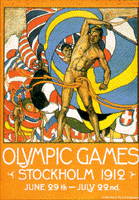HISTORY OF THE MODERN OLYMPICS
Stockholm, Sweden, 1912
 |
| Olympic posters from the Archives, Olympic Museum Lausanne, from the book The Olympic Spirit, published by Tehabi Books |
The star of the 1912 Olympics was the American Jim Thorpe. He was entered in four events, beginning slowly with a fourth-place finish in the high jump and a seventh-place finish in the long jump. In the pentathlon and decathlon, however, Thorpe dominated the events to win two gold medals. The track-and-field competition also featured the long-distance running of Hannes Kolehmainen of Finland, who won gold medals in the 5,000- and 10,000-metre runs and the 12,000-metre cross-country race. The 1912 Games saw the Olympic debuts of legendary fencer Nedo Nadi of Italy and American swimmer Duke Paoa Kahanamoku of Hawaii.
The 1916 Games, scheduled for Berlin, were cancelled because of the outbreak of World War I.
Introduction * Early History * Revival of the Olympics * Organization of the Modern Games